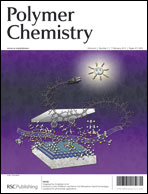In this study we report the molecular design, synthesis, characterization, and photovoltaic properties of a series of diketopyrrolopyrrole (DPP) and dithienothiophene (DTT) based donor–acceptor random copolymers. The six random copolymers are obtained via Stille coupling polymerization using various concentration ratios of donor to acceptor in the conjugated backbone. Bis(trimethylstannyl)thiophene was used as the bridge block to link randomly with the two comonomers 5-(bromothien-2-yl)-2,5-dialkylpyrrolo[3,4-c]pyrrole-1,4-dione and 2,6-dibromo-3,5-dipentadecyl-dithieno[3,2-b;2′,3′-d]thiophene. The optical properties of these copolymers clearly reveal a change in the absorption band through optimization of the donor–acceptor ratio in the backbone. Additionally, the solution processability of the copolymers is modified through the attachment of different bulky alkyl chains to the lactam N-atoms of the DPP moiety. Applications of the polymers as light-harvesting and electron-donating materials in solar cells, in conjunction with PCBM as acceptor, show power conversion efficiencies (PCEs) of up to 5.02%.

You have access to this article
 Please wait while we load your content...
Something went wrong. Try again?
Please wait while we load your content...
Something went wrong. Try again?


 Please wait while we load your content...
Please wait while we load your content...